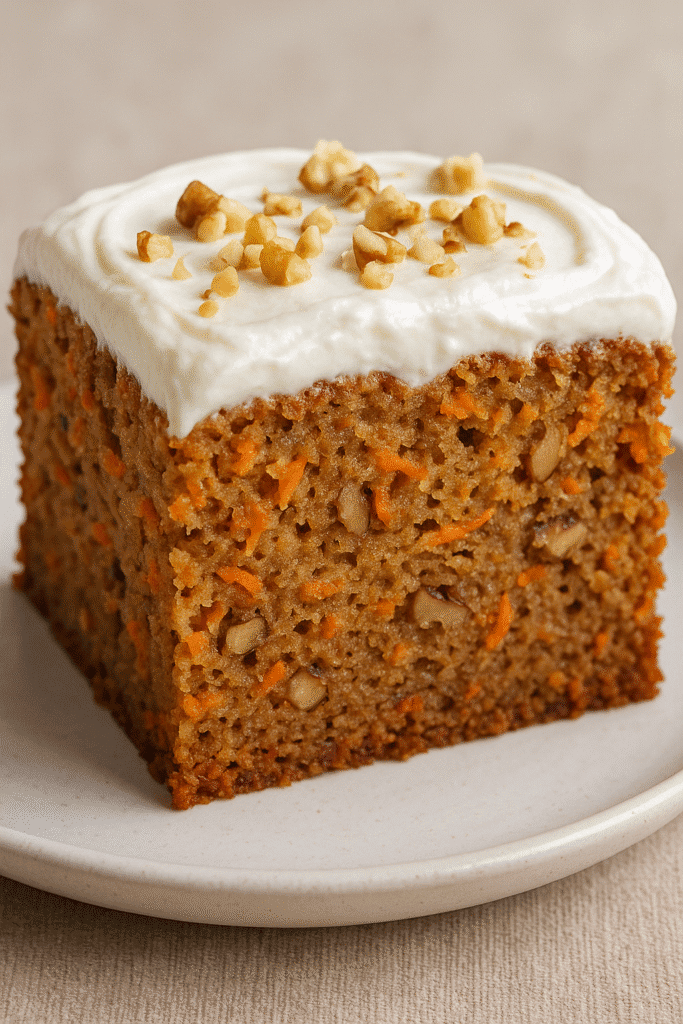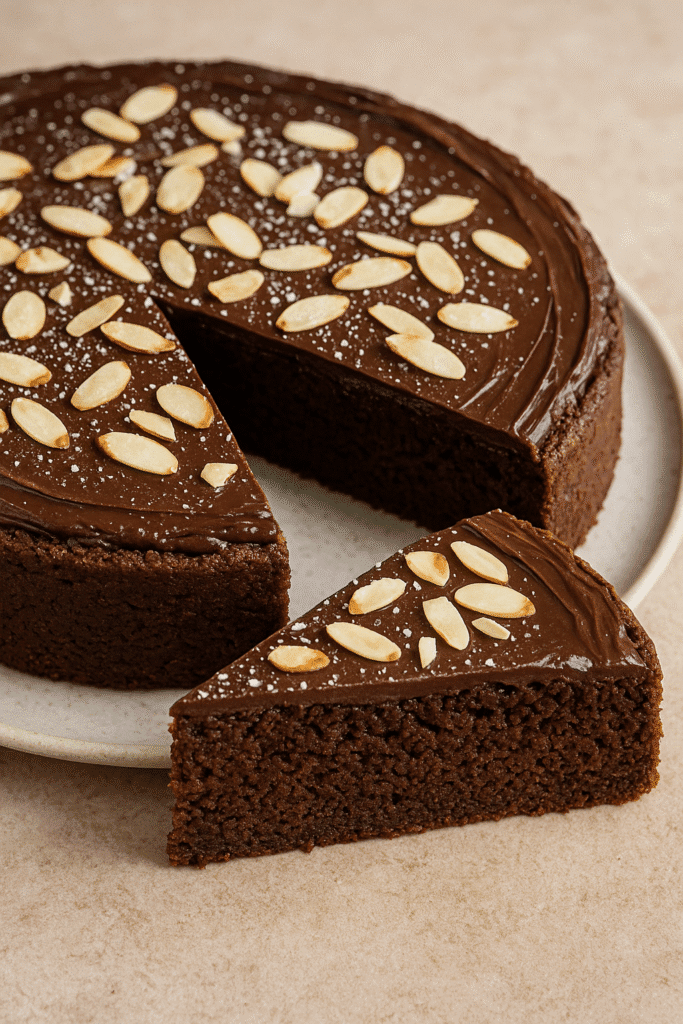A lighter, naturally sweetened better carrot cake that delivers flavor, moisture, and nourishment—without the sugar overload.

A Classic Dessert, Reinvented the Better Way
There’s something nostalgic and comforting about a slice of carrot cake. Maybe it’s the warm spices, the tender crumb, or that rich frosting on top. Whatever the reason, this dessert has stood the test of time. But let’s be honest: the classic version? It’s usually loaded with oil, sugar, and heavy cream cheese frosting—which can leave you feeling more sluggish than satisfied.
This better carrot cake skips the excess without sacrificing what makes the original so lovable. Made with wholesome ingredients like freshly grated carrots, whole wheat or almond flour, maple syrup, and topped with a Greek yogurt frosting, it’s moist, flavorful, and nutrient-packed. It’s the cake you’ll want to bring to every brunch, birthday, or afternoon tea—and feel good about eating too.
At TapedCircle, we believe that desserts should nourish your body and your soul. This better carrot cake strikes that perfect balance: comfort food, made clean.
Why A Better Carrot Cake
“Better” doesn’t just mean healthier—it means more thoughtful, more balanced, and more satisfying.
- Lower in added sugar – Naturally sweetened with maple syrup
- Frosting without cream cheese – Greek yogurt keeps it tangy and light
- Boosted with fiber and nutrients – Thanks to carrots, nuts, and whole ingredients
- Moist and flavorful – No dryness or bland bites here
- Perfect for mindful eaters – A treat you can enjoy with zero regret
Time to Prepare For A Better Carrot Cake
- Prep Time: 15 minutes
- Cook Time: 35–40 minutes
- Total Time: ~55 minutes
Ingredients For A Better Carrot Cake
For the Carrot Cake:
- 1 ½ cups almond flour or whole wheat flour
- 1 tsp baking soda
- ½ tsp baking powder
- 1 ½ tsp cinnamon
- ½ tsp nutmeg
- ¼ tsp ground ginger (optional)
- ¼ tsp salt
- 2 eggs
- ⅓ cup maple syrup or honey
- ¼ cup unsweetened applesauce
- ¼ cup melted coconut oil or olive oil
- 1 tsp vanilla extract
- 1 ½ cups grated carrots (about 2–3 medium carrots)
- Optional: ½ cup chopped walnuts or raisins
For the Greek Yogurt Frosting:
- ¾ cup plain Greek yogurt (full-fat or 2%)
- 2–3 tbsp maple syrup
- 1 tsp vanilla extract
- Pinch of sea salt
Instructions For A Better Carrot Cake
1. Preheat & Prep
Preheat your oven to 350°F (175°C). Line an 8-inch round or square cake pan with parchment paper and lightly grease the sides.
2. Mix Dry Ingredients
In a large bowl, whisk together the flour, baking soda, baking powder, cinnamon, nutmeg, ginger, and salt.
3. Mix Wet Ingredients
In another bowl, beat the eggs. Stir in maple syrup, applesauce, oil, and vanilla extract until well combined.
4. Combine & Fold
Add the wet mixture into the dry ingredients and stir until just combined. Fold in the grated carrots and any optional add-ins like walnuts or raisins.
5. Bake
Pour the batter into your prepared pan and smooth the top. Bake for 35–40 minutes, or until a toothpick comes out clean. Let it cool in the pan for 10 minutes before transferring to a rack.
6. Make the Frosting
While the cake cools, whisk together the Greek yogurt, maple syrup, vanilla, and salt until smooth and creamy. Chill until ready to use.
7. Frost & Serve
Once the cake is fully cooled, spread the Greek yogurt frosting over the top. Slice and serve!
Why Greek Yogurt Makes the Best Light Frosting
Greek yogurt isn’t just a healthier swap—it brings:
- Tangy flavor that mimics cream cheese
- Creamy texture with fewer calories
- Protein boost for better satiety
- Probiotics for gut-friendly benefits
- Less sugar than most frosting recipes
You can also flavor the frosting with orange zest, a dash of cinnamon, or a spoonful of almond butter for a unique twist.
Health Benefits of A Better Carrot Cake
- 🥕 Carrots – Rich in beta-carotene, fiber, and antioxidants
- 🌰 Almond flour or whole grains – Provide protein, healthy fats, and slow-digesting carbs
- 🍯 Natural sweeteners – Lower glycemic impact than refined sugar
- 🥄 Greek yogurt – High in protein and gut-friendly probiotics
- 🧁 Lower in sugar & fat – No butter, no refined frosting, no guilt
🍰 A Thoughtful Indulgence For A Better Carrot Cake
While this carrot cake is made with better-for-you ingredients, it’s still a sweet treat at heart. Think of it as a mindful indulgence—something to enjoy without guilt, but with intention. A small slice can satisfy, especially when you know it’s made with whole, nourishing ingredients.
Storage & Serving Tips For A Better Carrot Cake
- Store: Keep cake in the fridge for up to 4 days (frosted or unfrosted).
- Freeze: Freeze unfrosted cake for up to 2 months; thaw before frosting.
- Make-Ahead: You can bake the cake a day in advance and frost before serving.
This cake is even better chilled overnight—the spices and flavors deepen beautifully.
FAQs
Can I make this cake vegan?
Yes! Replace the eggs with flax eggs (2 tbsp flax + 6 tbsp water) and use a dairy-free yogurt for the frosting.
Can I use regular yogurt?
Yes, but make sure it’s thick or strain it in cheesecloth to avoid runny frosting.
Is this cake gluten-free?
It is if you use almond flour. Whole wheat flour makes it nutrient-dense but not gluten-free.
Can I turn this into muffins?
Absolutely. Pour the batter into a muffin tin and bake for 18–22 minutes.
Reader Reviews
⭐⭐⭐⭐⭐ “This is my new favorite carrot cake recipe. The Greek yogurt frosting is genius!” – Ellie M.
⭐⭐⭐⭐ “So moist and flavorful without the sugar overload. A keeper!” – James L.
⭐⭐⭐⭐⭐ “I made this for Easter brunch and it disappeared in minutes!” – Priya D.
Final Thoughts For A Better Carrot Cake
This better carrot cake hits the sweet spot—literally and nutritionally. It gives you that nostalgic spice and tender crumb, but with whole ingredients that make your body feel as good as your tastebuds do.
Perfect for birthdays, potlucks, or just a weekend treat, it proves that healthy baking doesn’t have to be boring. And with the Greek yogurt frosting, you’ll never miss the cream cheese.
References
- Harvard Health – root vegetables
- Cleveland Clinic – Is yogurt healthy?
Recent Posts

















